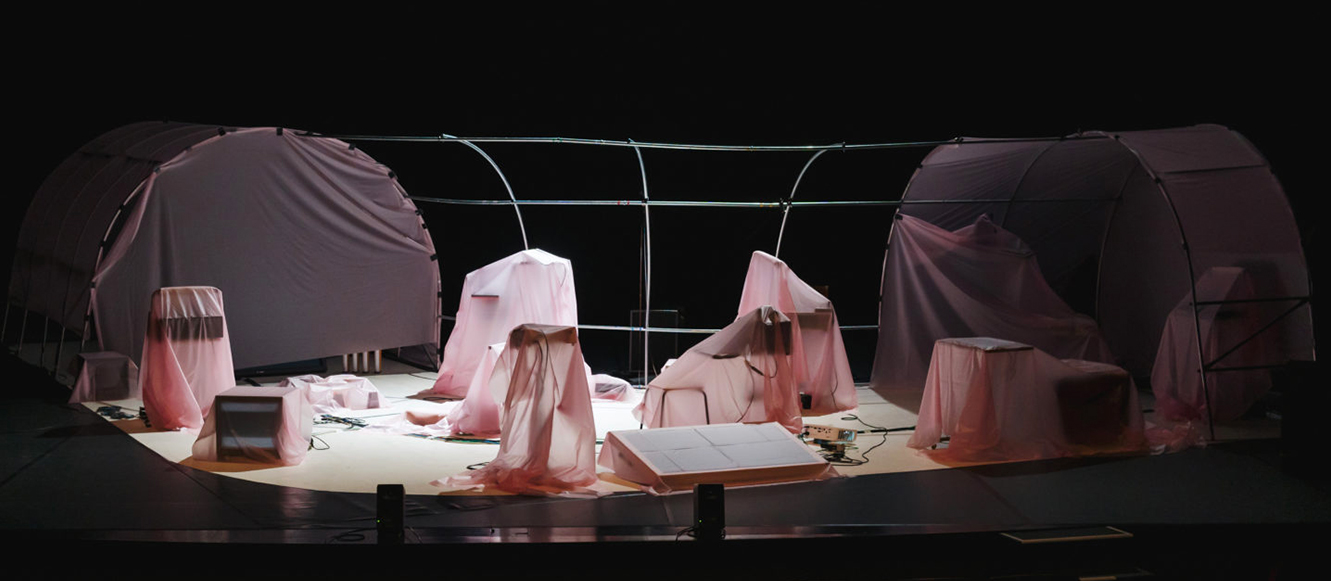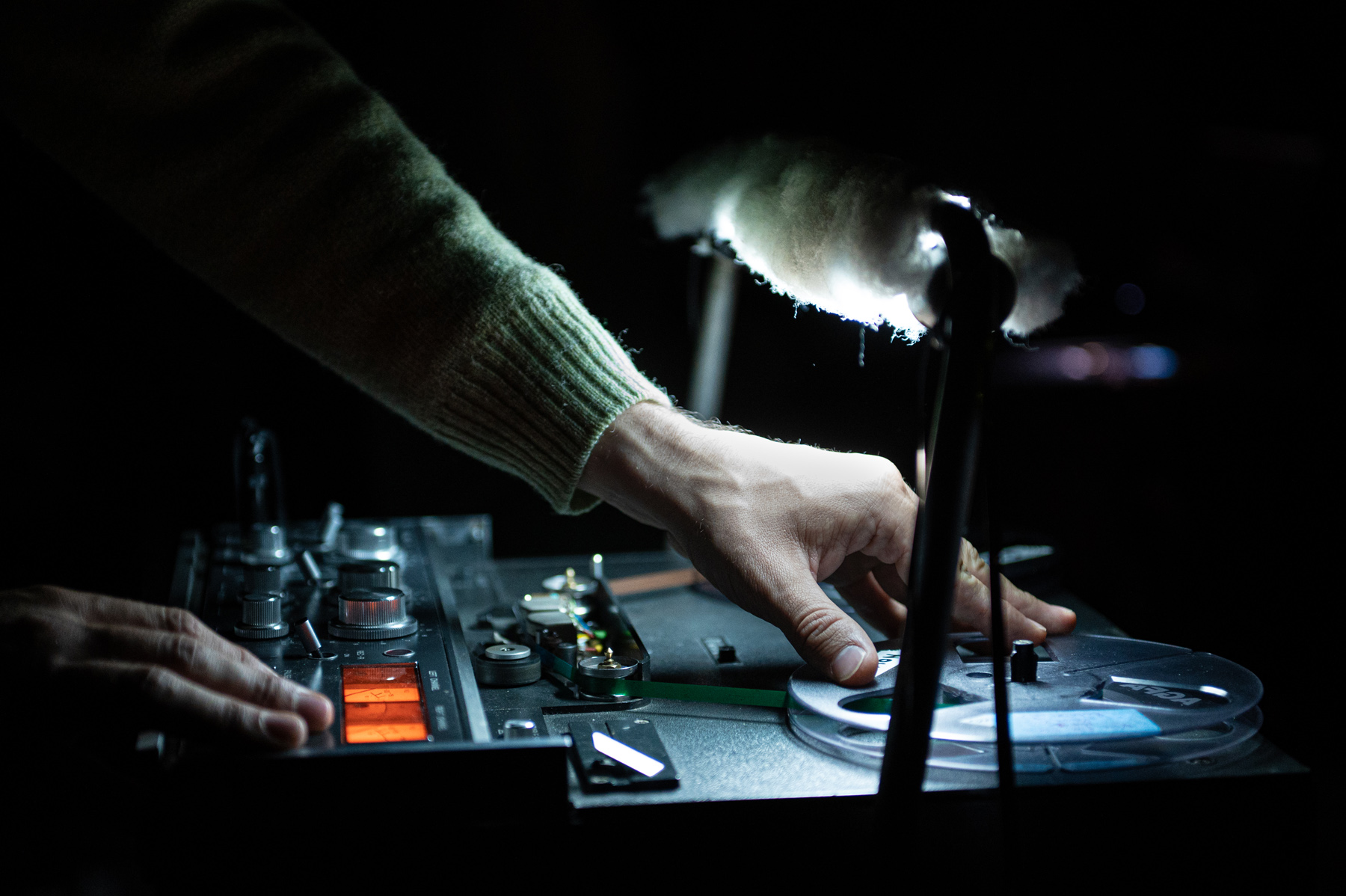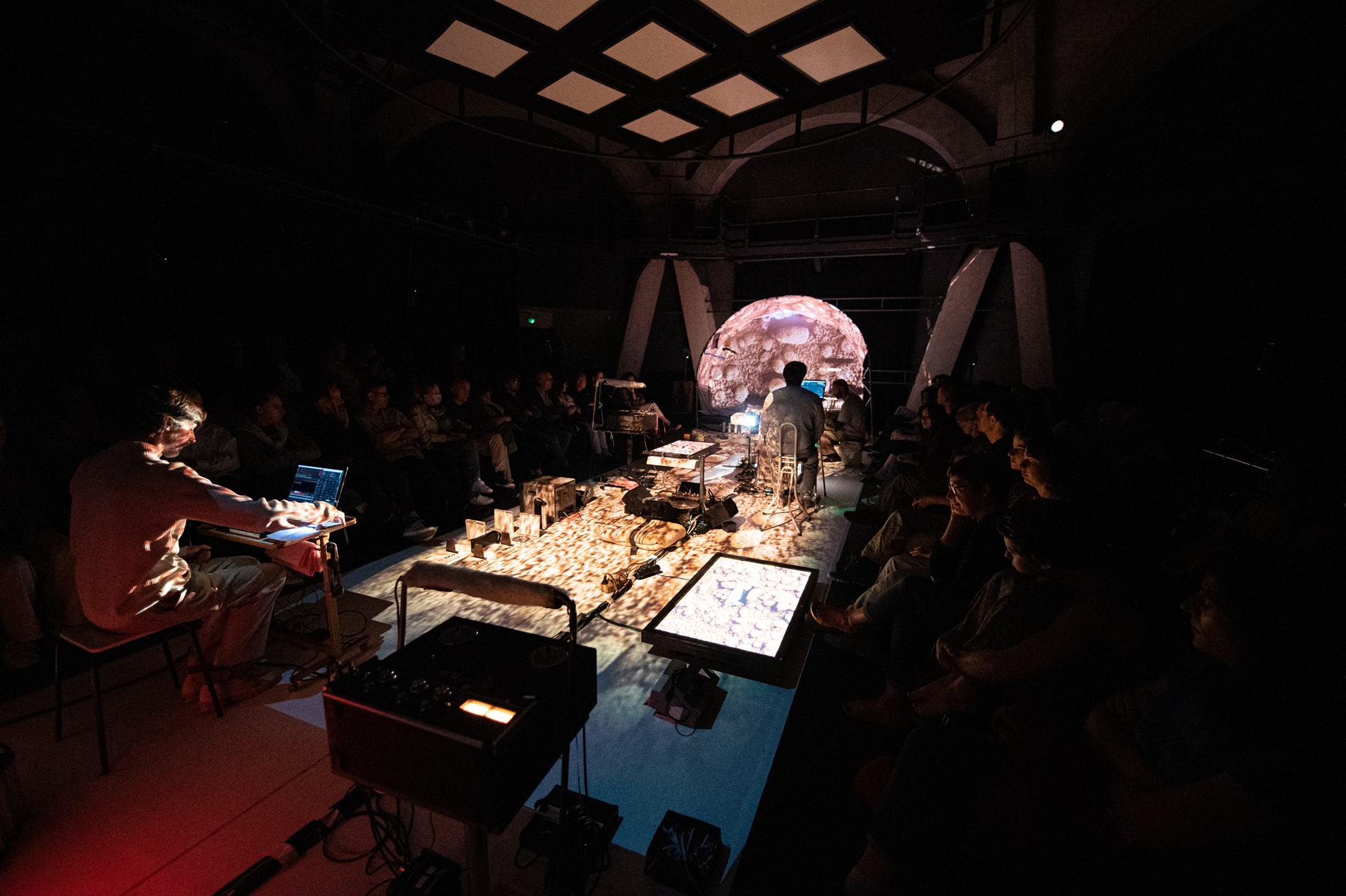The planetary catastrophe has already taken place... what is left to preserve for the future?
The story written by Lancelot Hamelin takes place in a parallel future, where a super-urban world is succumbing. A man tells us, in his overexposed voice, about a system on the verge of extinction. This character tries to make us hear the fragments of the living and non-living world before a definitive silence comes.
Alvise Sinivia brings together a multidisciplinary team to reflect on memory and trace. Like researchers, the playwright and director Maya Boquet, the sound designer Jocelyn Robert, the video artist Simon Rouby and the author Lancelot Hamelin have been collecting and classifying sound and visual images of different places and time-spaces for many years. Composer Paul Ramage sculpts these sound documents on an instrumentarium made of recording machines. What do these sounds tell us about a world on the verge of extinction?
By making future archaeology the object of a science-fiction fable, anchored in the codes and commonplaces of the genre, Le Hurle is a sound show haunted by the laws of chaos.
Production
Compagnie Alvise Sinivia
Coproduction
CNC - DICRéAM, La Pop, La Soufflerie, La Muse en circuit - CNCM (Alfortville), Nouveau théâtre de Montreuil - CDN
Hosted residency
Ircam - Centre Pompidou, GMEM, Villa Médicis, La Soufflerie, La Pop, La Manufacture des Oeillets (Ivry), La Muse en circuit-CNCM, Le Théâtre de L'Aquarium, Théâtre de Vanves
Partner
Ministère de la Culture - DRAC Île-de-France, Région Île de France
Alvise Sinivia
Pianist, improviser and performer
Many encounters with artists from all walks of life have marked his career (dancers, choreographers, circus artists, video artists, painters and visual artists). A curious musician who is constantly on the lookout, he is constantly renewing his relationship with the instrument, the paradoxes and limits of which he has been experimenting with for several years. Trained at the Conservatoire National Supérieur de Musique et de Danse de Paris with Alain Planès and Emmanuel Strosser. There he made numerous encounters that nourished his music. Involved in creation, he regularly collaborates with composers and participates in the Orchestre de Nouvelles Créations, Expérimentations et Improvisation Musicales. As a resident at the Villa Médicis during the 2016/2017 season in the performance discipline, he deepens his research on the relationship between movement and sound. He then set up his company with which he created the solo Ersilia. The whole body becomes a bow and plays the device-instrument invented for the piece. Currently, he is preparing a four-handed piece with Frédéric Blondy, Micrographia, which will be premiered next May at the Théâtre de Vanves.
Paul Ramage
Violinist, improviser and composer
Paul Ramage began his musical training at the age of ten with the violin. After meeting Didier Lockwood (whose school he joined in 2003), he became interested in jazz and improvised music. At the same time, he continued his studies of classical violin at the CRR of Cergy-Pontoise in the classes of Aude Lefevre and Franck Delavalle, and of chamber music with François Poly. He obtained a D.E.M. in jazz and violin. In 2013, he obtained his D.E.M in electroacoustic composition at the Paris Conservatory, in the classes of Denis Dufour and Jonathan Prager. He then obtained a Master's degree in electroacoustic composition at INA_GRM. He also attended the composition and computer music course at Ircam. Composer of about forty opuses, acousmatic as well as mixed or instrumental, he has played and been played in various countries (France, Spain, Italy, Portugal, Romania, United Kingdom, Japan, United States, China...). He is a laureate of the Metamorphosis Prize (Music and Research) of the second Russolo Prize (Russolo-Pratella Foundation, Italy) and holds the Certificate of Aptitude (C.A.) in electroacoustic composition. He teaches sound creation at the conservatories of Châtenay-Malabry and Bagneux. Today, he is a member of Alcôme (Company of creation and diffusion of contemporary music), and works to bring creation to life on all its sides.
Maya Boquet
Sound designer, performer and author
Maya Boquet works as . She probes the continuum between fiction and documentary, collecting stories, testimonies, life stories, soundscapes, which she approaches differently depending on the medium she adopts, radio, theater or writing. She tries to define a language specific to each of these media and seeks both their porosity and the aesthetic transfers they can undergo. She has written and directed radio fiction for France Culture, Longueur d'Ondes, collaborated with directors as a dramaturge (Matthieu Bertholet, Julien Fiséra), co-founded the Franco-Belgian group Radio Femmes Fatales which produces and performs radio plays live on stage. Since May 2014, she co-wrote with Emilie Rousset Les Spécialistes.
Jocelyn Robert
Engineer and sound editor
Jocelyn Robert graduated from Femis in 2007. He has participated in the soundtrack of many feature films, fictions and documentaries for nearly 15 years. In parallel to his job, and driven by his passion for field recording and sound design, he collects with professional microphones the sound ambiences of singular places such as the abandoned island of Hashima in Japan, the Kadikoy port of Istanbul at dawn, the Wailing Wall of Jerusalem, the Maracana stadium of Rio during a match, the New York subway, the fish market of Algeciras, the jungle of Palawan island in the Philippines... This large sound library is regularly used in the sound editing of films, but it is in the sound creation that it finds its full meaning.
Simon Rouby
Director
Coming from the animation cinema, Simon Rouby has been exploring for several years unexplored visual territories opened by new technologies. Pioneer of the use of 3D scanning in cinema to integrate sculptures in his first feature film Adama, it is through contact with geologists at the Geosciences Institute (GFZ) in Potsdam that he adapts his 3D scanning techniques to the scale of the landscape. Himalayas, Sub-Antarctic Archipelago of Kerguelen, Reunion Island, Nigeria, Japan... Since 2016, he has been accumulating digital data that he then shares in the form of video installations. The whole forms a puzzle reconstituted by the viewer, where fragments of landscapes drift like icebergs, creating by their collisions and successive superimpositions a composite world in permanent transformation.
Frédéric Stochl
Musician, dancer, director
Frédéric Stochl has received a triple training in music, choreography and theater. As a double bass soloist since 1980 with the Ensemble Intercontemporain (conducted by Pierre Boulez), he has participated in numerous creations, as well as with other institutions (Radio-France, GRM, ATEM, etc). He has been a dance and body education teacher at the Strasbourg National Theatre School, a double bass teacher at Chalon-sur-Saône and then at the Lyon and Paris Conservatories, and finally a chamber music teacher at the CNSMDP, where he also led an instrumental theater workshop. Frédéric Stochl also pursues an independent activity of inventing shows that want to intermingle music, theater and dance in the same expressive gesture.
DURATION
1h
Alvise Sinivia
artistic direction, composition
Paul Ramage
composition
Maya Boquet
dramaturgy, direction
Lancelot Hamelin
text, narrative
Franck Jamin
scenography
Jocelyn Robert
sound archive capture
Simon Rouby
video
Julien Soulatre
light
Frédéric Stochl
voices
Armando Balice
acousmonium





